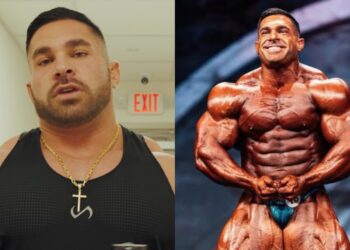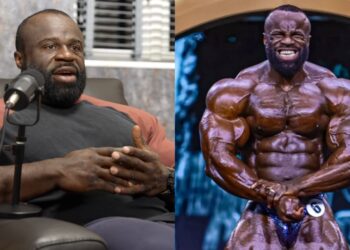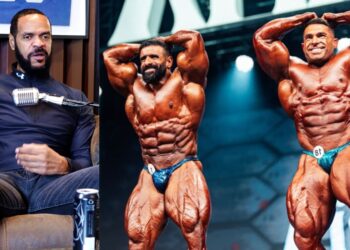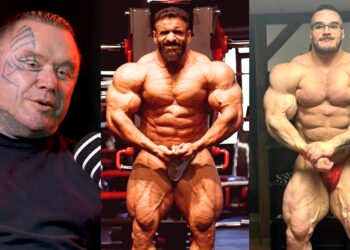“If there were only 10 exercises I could do for the rest of time to build muscle, what would those be?”
As a personal trainer, I often get this question from lifters aiming for hypertrophy.
Commercial gyms can be overwhelming. They have endless rows of equipment with hundreds of exercises you can do on them. While exercise variety is key to avoiding plateau and gaining muscle consistently, switching up the exercises too often can lead to suboptimal results, as the body may not have enough time to adapt and progress with each movement pattern.
In this article, I will share the 10 most effective hypertrophy-inducing exercises for men. I will include exercises for every muscle group to ensure balance, symmetry, and overall strength and muscle development.
The Big 3: Foundation for Strength
Whether your goal is to gain new muscle tissue or strength, you must master the big three lifts (as they are known in powerlifting) to build a solid foundation. These multi-joint exercises are incredibly effective for torching calories and triggering hormonal responses needed to gain muscle mass in men.
As a beginner, your goal should be to master the movement mechanics of these exercises before you start adding more weights to the bar.
Level Up Your Fitness: Join our 💪 strong community in Fitness Volt Newsletter. Get daily inspiration, expert-backed workouts, nutrition tips, the latest in strength sports, and the support you need to reach your goals. Subscribe for free!
1. Squats
A rock-solid lower body is vital for building a strong foundation. Building tree-trunk legs will also boost metabolism, which will help you burn more fat throughout the day, even when you are physically inactive. This exercise biases the quads, glutes, and hamstrings while also targeting the core, back, and even your calves.
There are multiple variations you can choose from. However, the barbell back squat is the gold standard and is incredibly effective for building overall strength and muscle mass. You can switch to the front squat to shift the focus to the quads and core stability. Goblet squats, on the other hand, are an excellent pick for beginners or people with mobility issues.
I recommend the Smith machine squats to bodybuilders trying to improve their quads and glutes. The multiple-time Classic Physique Olympia champ Chris Bumstead is a proponent of the Smith machine squats and favors them over the conventional barbell back squats.
“I love squatting in the Smith machine, and I get a lot of shi* for that,” said Chris Bumstead.
According to a Sports (Basel) study, eight to 12 repetitions per set with 60 to 80 percent of your one-rep maximum (1RM) optimizes hypertrophic gains. On the other hand, one to five reps per set with 80 to 100 percent of your 1RM promotes strength gains. (1)
You must stay within the three to five set range and limit performing the same exercise and muscle group to twice weekly. These recommendations will stay the same for all exercises listed in this article.
2. Deadlifts
Deadlifts are the ultimate posterior chain (glutes, hamstrings, lower back) builder and boost your athletic performance and daily functionality. Furthermore, there is something primal about lifting heavy stuff off the ground and putting it back down. This exercise, combined with squats, helps build overall resilience and grit.
You must begin with the conventional deadlift, which involves a hip-width stance and a shoulder-wide overhand or mixed grip. Lifters with better lower body mobility can also try the sumo deadlift, which emphasizes the glutes and erector spinae muscles.
Beginners can also try trap bar deadlifts, which involve a wider neutral grip to focus on the quads and limit lower back strain.
Most lifters make the mistake of dropping the bar to the floor after locking it out. However, they leave gains on the table by overlooking the eccentric phase. Use slow and controlled negatives to maximize target muscle engagement and adaptations.
3. Bench Press
A broad and muscular chest separates the men from the boys. The bench press helps build pressing strength and trains the chest, shoulders, and triceps, which translates to better performance in other compound exercises.
Irrespective of the bench press variation you perform, avoid flaring your elbows too wide, as this can strain the shoulder rotator cuffs, increasing the risk of injury. I usually prefer dumbbell bench presses over barbell variations, as they allow an extended range of motion (ROM), leading to greater chest fiber activation.
Furthermore, performing single-arm dumbbell presses can help identify and fix muscle and strength imbalances. When you have the option, opt for the incline bench press variation, as it biases the upper chest, which is a lagging muscle group for most people.
Keep your shoulder blades retracted during the bench press and pause in the bottom position for a second to maximize chest stimulation. Then, explode to the starting position to build upper body strength.
Pulling Power
You must focus on pulling exercises to build a diced back and mighty biceps. The best thing about training these muscle groups is that you don’t need a gym full of fancy equipment for them. Just two exercises done right can completely transform your back and biceps.
4. Pull-Ups or Chin-Ups
Many people use ‘pull-ups’ and ‘chin-ups’ interchangeably. However, they are two distinct exercises that bias different muscle groups.
Pull-ups involve a wider-than-shoulder-width overhand grip and target the upper back muscles. On the other hand, chin-ups comprise a shoulder-wide underhand grip and train the biceps and lats.
Besides the upper back, shoulders, and arms, pull-ups and chin-ups also fire up your core, as they are required to stabilize the body. As you get stronger, you can use a dip belt to add external resistance and make the exercise more challenging.
On the flip side, beginners can start with assisted pull-ups using a resistance band if they can’t perform a bodyweight pull-up yet. That said, you must focus on slowly lowering yourself to build the requisite upper body strength.
5. Deficit Barbell Bent-Over Rows
While the conventional barbell bent-over rows are great, too, I prefer the deficit variation, as it allows for a deeper stretch and, therefore, greater muscle activation. Lifters trying to build functional strength should avoid chest-supported rowing variations as they limit core engagement.
Level Up Your Fitness: Join our 💪 strong community in Fitness Volt Newsletter. Get daily inspiration, expert-backed workouts, nutrition tips, the latest in strength sports, and the support you need to reach your goals. Subscribe for free!
Focus on following a full ROM; the bottom of the weight plates should at least be below the top of the elevated surface, or else it beats the entire purpose of using a platform. Retract the shoulders on the concentric phase and pinch them together at the top to maximize lat engagement.
Remember to start light and gradually increase the weights as you get stronger. To limit lower back strain, avoid rounding your back during the exercise.
“Bent-over rows and pull-ups take care of the rear delts, given you perform them with a full range of motion,” said Dr. Mike Israetel (Ph.D. in Sports Physiology)
Bonus Exercise: Seated Incline Dumbbell Curls
Who doesn’t love bonuses? If you cannot go without performing a dedicated bicep exercise, let it be the seated incline dumbbell curls.
In contrast to the conventional dumbbell curls, where there is no tension on the biceps in the bottom position, the incline position keeps constant tension on the biceps brachii in the fully stretched position.
Keep your elbows in front of the shoulder throughout the exercise to limit the potential of using momentum and ensure the biceps are moving the weights.
Pushing Power
Pushing exercises focus on the chest, shoulders, and triceps. Since we have already covered the bench press, we will stick to the shoulder and tricep exercises in this section.
6. Overhead Press
Overhead pressing exercises are complete shoulder builders. You can choose between multiple movements, including the military press, overhead press, shoulder press, and push press, to ensure variety and consistent gains.
Besides the shoulders, these compound exercises target the triceps, upper chest, and even your core. You can alternate between dumbbell and barbell overhead presses, depending on your training experience and objectives.
Barbell variations are better for lifting heavier weights, whereas dumbbell presses can promote balance. Plus, performing these exercises while standing leads to greater core engagement, whereas back-supported variations can be a better option for those with lower back issues.
7. Dips
Dips can be used to train the chest and triceps. However, to bias the triceps, you must keep your wrists, elbows, and shoulder joints stacked and torso upright throughout the ROM.
Beginners can start with the bench dips but must transition to the parallel bar variation as they gain more experience and get stronger. A 2022 study found that “the bar dip is an appropriate progression from the bench dip due to the higher peak muscle activations.” (2)
Like the pull-ups, adding a dip belt can make this exercise more challenging and avoid hitting a plateau.
Jacked Legs
Let’s be honest, gents: nobody gets respect with chicken legs. A pair of jacked legs is necessary to build a strong foundation for total-body strength, athletic performance, and a head-turning physique.
8. Bulgarian Split Squats
This is arguably the most despised lower body exercise of all time. However, Bulgarian split squats are incredibly effective for fixing muscle and strength imbalances, as they work each leg individually through a full range of motion. It also promotes lower body stability and overall stability and balance.
Use an elevated platform that is at least knee high, and your front foot should be far enough forward so that you can comfortably touch your elevated knee to the floor without losing balance.
Keep your torso upright to load the quads, whereas leaning forward slightly can lead to greater glute and hamstring recruitment.
Beginners can perform this exercise while holding onto a sturdy object with one hand to maintain their balance. You could also use a Smith machine to add resistance without compromising stability.
9. Romanian Deadlifts
RDLs should be your go-to move for thick and powerful hamstrings and glutes. They can also help develop the coveted Christmas tree lower back. Focus on using slow eccentrics to optimally load the target muscles on this hip-hinge exercise, promoting hypertrophy, maximizing performance, and preventing injuries.
Using dumbbells in this exercise can help achieve an extended ROM. Keep your chest proud and back flat throughout the exercise to limit lower back strain. Push your hips back as far as possible, lower the weights until you feel a deep stretch in the glutes, and pause in the bottom position for a few seconds.
Core Strength
It’s easy to overlook core exercises when talking about 10 exercises for building muscle. However, you are as strong as your weakest muscle group. A jacked core can boost your performance in functional exercises and significantly reduce injury risk.
10. Hanging Leg Raises
Since hanging leg raises involve hanging on a pull-up bar, they result in complete core isolation and activation, from your lower abs to your obliques and deep stabilizing muscles.
Hanging from a bar is also good for shoulder and spine health and can improve posture. To isolate the abs, you must keep your midline steady throughout the exercise. Using momentum to lift your legs can lead to secondary muscle engagement, including the lats.
Keep your knees locked out and raise the legs until they are at least parallel to the floor for optimal core muscle recruitment. Pause at the top of your ROM for a one-count squeeze.
Conclusion
There you have it, gentlemen — the only 10 exercises you need to build a powerful, muscular physique. The best thing about these lifts is that you can do them with minimal equipment in your garage gym.
Prioritize good form over lifting heavy, and you will be well on your way to sculpting your body into a masterpiece. So, what are you waiting for? Get after it, tiger!
References
- Schoenfeld BJ, Grgic J, Van Every DW, Plotkin DL. Loading Recommendations for Muscle Strength, Hypertrophy, and Local Endurance: A Re-Examination of the Repetition Continuum. Sports (Basel). 2021;9(2):32. Published 2021 Feb 22. doi:10.3390/sports9020032
- McKenzie, A., Crowley-McHattan, Z., Meir, R., Whitting, J., & Volschenk, W. (2022). Bench, Bar, and Ring Dips: Do Kinematics and Muscle Activity Differ?. International journal of environmental research and public health, 19(20), 13211.








